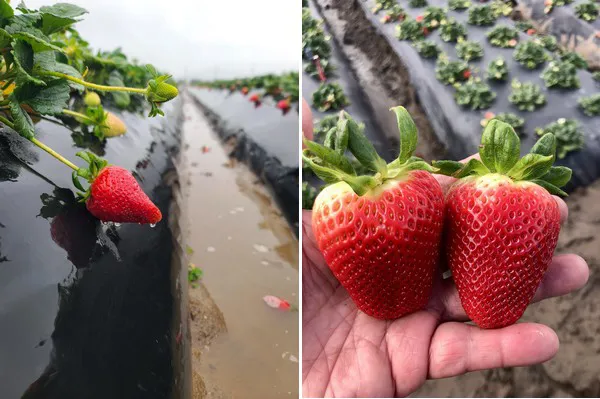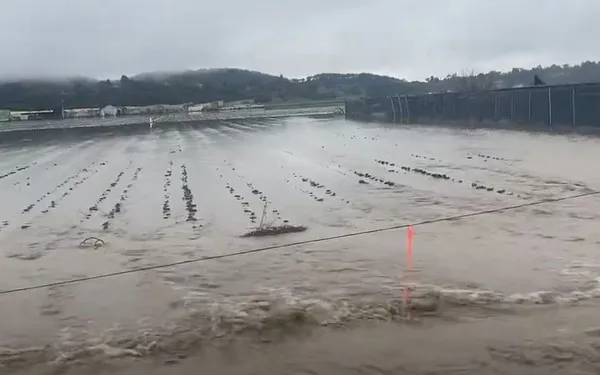Ag growers and shippers in affected parts of California are taking stock following late last week and the weekend’s rains, and the ones still coming.
The Central Coast particularly has seen significant rain and cooler-than-normal temperatures over the past several weeks, and another atmospheric river is forecast to bring heavy rain and wind through Wednesday. In Santa Maria and Oxnard, another one to three inches of rain is expected this week.
Kyla Oberman of California Giant Berry Farms notes that Saturday, the Pajaro River breached a levee causing flooding to the Pajaro area – including several thousand acres of ag land and the residential community of Pajaro. The following day, the Salinas River reached flood stage, causing flooding to the Salinas Valley, which also impacted a significant amount of agriculture. “It is too early for us to determine what impact there will be to our fields in these flooded areas. Our teams won’t be able to assess the affected strawberry ranches until the water recedes,” she says.
 Photo: California Giant Berry Farms
Photo: California Giant Berry Farms
As for the Oxnard and Santa Maria ranches, Oxnard production is ramping up. “Though exceptional rain and below normal temperatures have slowed down the ripening of the berries, Santa Maria volume continues to increase week over week and is expected to reach its peak season volume in late April through May,” Oberman says. “Following each rain event, crews work quickly to clean up the plants, discarding damaged fruit so as to get back to harvesting high quality, clean packages as best as possible.”
She also adds that these California strawberry plants are still young and strong and that the excess rain will help strengthen them. “As a result, we expect a strong mid to late southern California season once spring arrives. Unfortunately, the land has reached its maximum absorption, and we are now feeling the impact, such as these floods around the Central Coast,” she says.
Here’s what’s also happening in other California commodities.
Avocados: “Rain has brought much-needed water to California avocado groves. There has been some damage from strong winds that have blown fruit off trees,” says Peter Shore of Calavo Grown Sales. He notes that the crop is estimated at 257 million lbs., a number that could be slightly lower after fully assessing the wind damage. The season is still expected to begin with good volume in April.
 Photo: California Giant Berry Farms
Photo: California Giant Berry Farms
Blueberries: “The bees aren’t flying like they should during this time of year, so pollination is being affected,” says Michelle Carpenter of Gourmet Trading. “We were fortunate enough to get a fungicide application on before the rains, but some farmers couldn’t get into their fields, so they had to spend more money to put it on by air.”
Accessing fields is another challenge. “The roads to get out to the farm are flooded, making it difficult to get to the ranch itself. Yesterday it took me over an hour to get to the ranch because I hit so many main road closures. The dirt roads are flooded and a muddy mess as well. Even with four-wheel drive, you can’t get through,” says Carpenter. She adds while it is important fertilizer and nutrients are put on the plants at this time of year, the fields are too saturated to try to irrigate more, so the plants aren’t getting vital nutrients.
Citrus: “Overall, it's been a very good citrus season! We're seeing lots of high quality, high flavor citrus coming out of the ranches with a solid supply of organic and conventional mandarins and organic lemons and Navel oranges,” says Bianca Kaprielian of Fruit World, noting that there have been slightly shorter crops on specialty citruses such as Minneolas, Cara Caras and Blood oranges. “If we look at the citrus season as a whole, we're not going to see any major disruptions, though the season might be extended a few weeks.”
 Photo: California Giant Berry Farms
Photo: California Giant Berry Farms
Kaprielian does note that, in the short term, there may be a small disruption in supply while waiting for the ranches to dry out before harvest is able to resume. “That said, ahead of this most recent storm, we were able to harvest extra mandarins and lemons, so we won't see any interruptions on those items,” says Kaprielian.
Tree/stone fruit: Ray England of DJ Forry notes that while its two big commodities, grapes and pomegranates, aren’t even in bloom yet, the rain is impacting the ability to get into the fields and do the appropriate pruning and applications. “One thing we are seeing is that bloom on many tree fruits like cherries and stone fruit is a couple of weeks behind the last few years, which is due to both the rain and unusually cold weather,” he says.
Vegetables: While the rain and snow received are welcome since it provides growers with more water allocation for the coming growing seasons, it has also delayed future plantings in the Central Valley for the upcoming spring and summer seasons. “The fields we are currently harvesting in have been spared from the rain. They’ve had a couple of days of measured precipitation but nothing to stop us from harvesting,” says Jay Angulo of Baloian Farms.
In terms of logistics though in getting product around the state, this storm was a different story. “Previous storms have greatly affected logistics, with snow closing many of the highways and mountain passes out of the state. The storm from late last week/this weekend was a warmer storm, and the fear was actually that it would melt some of the snow we’ve received prematurely,” says Angulo.
Looking ahead, 2023 has provided some education on handling the storms. “While there is a level of concern for tomorrow’s storm, from a production standpoint, we feel we are more prepared to deal with the coming weather,” says Matt Hiltner of Babé Farms. “Our team learned a lot from the atmospheric river we experienced in January and have taken steps that will hopefully minimize the loss in the fields. We also got ahead of the game and harvested some of our big movers in advance to build up inventory.”
For more information:
Kyla Oberman
California Giant Berry Farms
https://www.calgiant.com/
Peter Shore
Calavo Grown Sales
http://www.calavo.com/
Michelle Carpenter
Gourmet Trading Co.
www.gourmettrading.net
Bianca Kaprielian
Fruit World
https://www.fruitworldco.com/
Ray England
DJ Forry
www.djforry.com
Jay Angulo
Baloian Farms
www.baloianfarms.com
Matt Hiltner
Babé Farms, Inc.
www.babefarms.com
